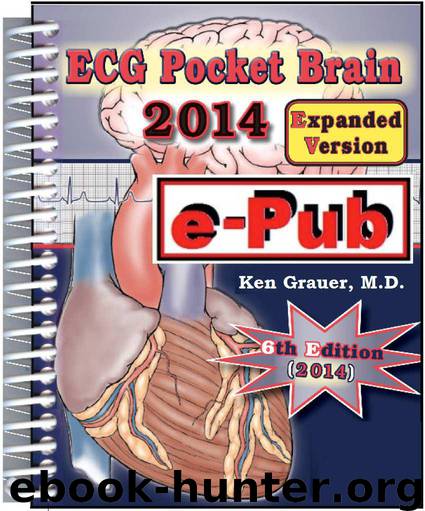ECG-2014-Pocket Brain (Expanded) by Grauer Ken

Author:Grauer, Ken [Grauer, Ken]
Language: eng
Format: epub
Publisher: KG/EKG Press
Published: 2014-01-15T14:00:00+00:00
Figure 08.19-1: ECG criteria for RAA (P pulmonale). Most commonly — ECG diagnosis of RA is made from P wave appearance in lead II (tall, peaked and pointed P wave at least 2.5 mm tall). The P wave looks, “uncomfortable to sit on”. On occasion — RAA may be suggested by the finding of a pointed positive component to the P wave in lead V1.
08.20 – ECG Diagnosis of LAA: P Mitrale
LAA (Left Atrial Abnormality) — is diagnosed by finding an m-shaped (notched) and widened P wave (≥0.12 second) in a "mitral" lead (I,II,aVL ) — and/or a deep negative component to the P wave in lead V1 = P Mitrale (Figure 08.20-1).
The reason the P wave becomes wider with LAA is that the left atrium is activated after the right atrium (since the SA Node is in the RA). It is addition of this LA component to the P wave that produces the notch/extra ‘hump’ to form the “M” in lead II.
The best ECG sign of LAA is the finding of a deep, negative component to the P wave in lead V1 — that is at least 1 little box deep or wide.
We generally undercall LAA — because of the overall poor specificity the ECG has for atrial enlargement. Remember that some negativity to the P wave in lead V1 is a normal finding! Therefore, it is best not to even contemplate an ECG diagnosis of “LAA” — unless the negative component to the P wave in lead V1 is definitely at least 1 little box deep and/or wide.
Download
This site does not store any files on its server. We only index and link to content provided by other sites. Please contact the content providers to delete copyright contents if any and email us, we'll remove relevant links or contents immediately.
Periodization Training for Sports by Tudor Bompa(8171)
Why We Sleep: Unlocking the Power of Sleep and Dreams by Matthew Walker(6618)
Paper Towns by Green John(5092)
The Immortal Life of Henrietta Lacks by Rebecca Skloot(4526)
The Sports Rules Book by Human Kinetics(4296)
Dynamic Alignment Through Imagery by Eric Franklin(4118)
ACSM's Complete Guide to Fitness & Health by ACSM(3989)
Kaplan MCAT Organic Chemistry Review: Created for MCAT 2015 (Kaplan Test Prep) by Kaplan(3940)
Introduction to Kinesiology by Shirl J. Hoffman(3726)
Livewired by David Eagleman(3685)
The Death of the Heart by Elizabeth Bowen(3553)
The River of Consciousness by Oliver Sacks(3542)
Alchemy and Alchemists by C. J. S. Thompson(3451)
Bad Pharma by Ben Goldacre(3357)
Descartes' Error by Antonio Damasio(3231)
The Emperor of All Maladies: A Biography of Cancer by Siddhartha Mukherjee(3068)
The Gene: An Intimate History by Siddhartha Mukherjee(3049)
The Fate of Rome: Climate, Disease, and the End of an Empire (The Princeton History of the Ancient World) by Kyle Harper(3006)
Kaplan MCAT Behavioral Sciences Review: Created for MCAT 2015 (Kaplan Test Prep) by Kaplan(2941)
